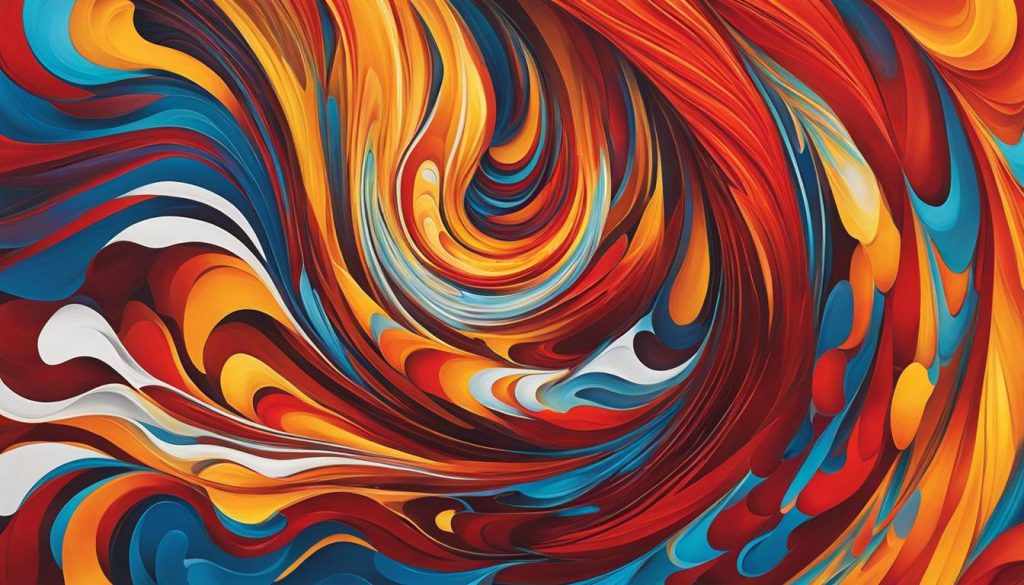Hello, I’m here to explore the fascinating world of color therapy and its psychological benefits. Color therapy, also known as chromotherapy, has a rich history dating back to ancient civilizations like the Egyptians and Greeks. This alternative form of therapy utilizes the power of colors and light to promote healing and well-being.
Color therapy posits that different colors can influence our energy and impact our mental and physical health. For example, red is believed to boost energy, blue promotes relaxation, green aids in stress relief, yellow improves mood, and orange elicits happiness. While this theory may sound intriguing, it’s important to note that scientific evidence supporting color therapy’s effectiveness in treating medical conditions is limited.
Key Takeaways:
- Color therapy, or chromotherapy, uses colors and light to treat mental and physical health conditions.
- Colors are believed to affect energy levels and well-being, with each color having unique properties.
- Scientific research on color therapy is ongoing, and its effectiveness is still being explored.
- Color therapy can provide psychological benefits, such as stress relief and mood improvement.
- While color therapy can be incorporated into daily life, it should not replace medical treatment.
The Science Behind Color Therapy
The science behind color therapy is fascinating, although it is still being researched and understood. Color therapy, also known as chromotherapy, explores the effects of color on the human mind and body. It is believed that colors can enter our bodies through our eyes or skin, and each color has a unique wavelength and frequency that can have different effects on people.
Warm colors, such as red and orange, are typically used for their stimulating effects, while cool colors, like blue and green, are employed for their calming properties. These color therapy techniques aim to tap into the power of color symbolism to promote healing and well-being.
Chromotherapy is considered a form of alternative medicine treatment, and it has been purported to help with a variety of conditions. However, it is important to note that there is limited scientific evidence to support these claims. Ongoing color therapy research is exploring the potential therapeutic applications of color therapy, including its effects on pain management and mental health.
To better understand the effects of color therapy, let’s take a closer look at some key aspects:
- Color wavelengths and frequencies: Each color has a specific wavelength and frequency that can affect our mind and body in different ways.
- Warm and cool colors: Warm colors are associated with stimulation and energy, while cool colors are linked to relaxation and calmness.
- Color symbolism: Colors carry symbolic meanings that can influence our emotions and overall well-being. For example, blue is often associated with tranquility and trust, while yellow is associated with happiness and optimism.
Although there is ongoing research, it is important to approach color therapy with an open mind and to consult with a healthcare professional for personalized advice and treatment.
The Psychological Benefits of Color Therapy

Color therapy has long been believed to provide numerous psychological benefits. Different colors are thought to have specific effects on our mood and emotions, offering potential relief for various psychological concerns. Whether you’re feeling stressed, lacking energy, or experiencing seasonal affective disorder, color therapy may offer some solace.
When it comes to stress relief, certain colors like blue and green have been noted for their soothing effects. These colors can help create a calm and serene environment, promoting relaxation and reducing anxiety. Simply surrounding yourself with these colors or incorporating them into your daily life can have a positive impact on your overall well-being.
If you’re looking to boost your appetite or energy levels, warm and stimulating colors may be the way to go. Colors like red, orange, and yellow are known to evoke feelings of warmth and vitality, which can enhance your appetite and provide a much-needed energy boost. Incorporating these colors into your surroundings or even in your choice of clothing can help uplift your mood and invigorate your energy levels.
Seasonal affective disorder (SAD) is a condition that affects many individuals during colder months when exposure to sunlight is limited. Color therapy suggests that warm colors like yellow and orange can help alleviate the symptoms of SAD by mimicking the effects of sunlight. Surrounding yourself with these colors or using them strategically in your environment can potentially boost your mood and combat the wintertime blues.
While color therapy can offer psychological benefits, it is essential to remember that it should not be seen as a definitive treatment for mental health conditions. If you are experiencing significant psychological concerns, it is always best to consult with a healthcare professional for proper diagnosis and treatment. They can provide personalized guidance tailored to your specific needs.
Overall, color therapy is a complementary approach that can enhance your well-being and help improve your mood. By incorporating colors strategically in your environment and daily life, you can potentially experience the psychological benefits that color therapy has to offer.
Incorporating Color Therapy Into Your Life

While the science behind color therapy is still being explored, there are ways to incorporate certain aspects of color therapy into your life. By making intentional choices regarding color, you can tap into the potential benefits of color therapy, such as stress relief and improved sleep quality.
Dealing with Stress and Insomnia
One way to utilize color therapy for stress relief and better sleep is by avoiding blue lights at nighttime. Blue light from electronic devices can disrupt your sleep patterns by suppressing the production of melatonin, the hormone responsible for regulating sleep. To promote restful sleep, consider using a color filter or switching to warmer, softer lighting in your bedroom. This will help adjust your circadian rhythm and enhance your overall sleep quality.
Using Color Choices Intentionally
Another way to incorporate color therapy into your life is by being intentional about the colors you surround yourself with. Certain colors have been associated with specific emotions and moods. For example, green is often linked to relaxation and stress relief, while yellow is commonly associated with happiness and positivity. By choosing colors that align with the mood or atmosphere you want to create, you can enhance your emotional well-being and overall outlook.
Limitations of Color Therapy
It is important to note that color therapy should not be relied upon as the sole treatment for any medical condition. While there are anecdotal reports and some limited evidence supporting the psychological effects of colors, it is not a substitute for professional medical advice or treatment. If you have any concerns about your physical or mental health, it is always recommended to consult with a healthcare professional.
Although color therapy can be a useful complementary approach to promote relaxation, manage stress, or improve sleep, it is not a panacea. The limitations of color therapy include the lack of widespread scientific support for its effectiveness and the individual variability in how colors are perceived and experienced. It is essential to approach color therapy with an open mind, understanding its potential benefits while acknowledging its limitations.
Embracing color therapy as part of your lifestyle can be an enjoyable and creative way to enhance your well-being. Experimenting with different colors and being mindful of their effects on your emotions can help you find a harmonious balance in your life. Remember, color therapy is just one tool among many, and it is always advisable to consult with a healthcare professional for comprehensive care.
Conclusion
While scientific research on the effectiveness of color therapy for medical conditions is still limited, many individuals have reported positive experiences and benefits from incorporating color therapy into their lives. As a complementary or alternative therapy, color therapy holds potential for psychological well-being. It is important to recognize that colors can have a unique impact on each individual, and the effects may vary. Therefore, it is essential to approach color therapy with an open mind and seek professional guidance for any medical concerns.
Color therapy provides an avenue to enhance mood and overall well-being. By understanding the psychological benefits associated with different colors, individuals can intentionally incorporate colors into their daily lives for specific purposes. For example, soothing colors like blue and green can be used to alleviate stress and anxiety, while warm and stimulating colors are believed to boost energy levels and appetite. However, it is crucial to note that color therapy should never replace evidence-based medical treatments, and consultation with healthcare professionals is always recommended.
Although color therapy may not be widely accepted in Western medicine, its long-standing history and positive testimonials suggest that further exploration and research are warranted. Colors play a significant role in our lives, influencing our emotions and perceptions. While color therapy might not be a definitive treatment for medical conditions, it is worth considering as a complementary practice for achieving psychological balance and self-care. Remember, colors have the power to positively impact our well-being, but it is essential to rely on evidence-based medical treatments and guidance in addressing any health concerns.
FAQ
What is color therapy?
Color therapy, also known as chromotherapy, is a form of therapy that uses color and light to treat certain mental and physical health conditions.
How does color therapy work?
Color therapy is based on the belief that certain colors can impact a person’s energy and health outcomes. Different colors are believed to have different effects on the body.
What are the psychological benefits of color therapy?
Color therapy is believed to have several psychological benefits, such as soothing effects on stress and anxiety, boosting appetite and energy levels, and potentially alleviating symptoms of seasonal affective disorder.
Can color therapy be used as a standalone treatment for mental health conditions?
Color therapy should not be seen as a definitive treatment for mental health conditions. It is always best to consult with a healthcare professional for proper diagnosis and treatment.
How can I incorporate color therapy into my life?
You can incorporate certain aspects of color therapy into your life by adjusting your exposure to blue lights at nighttime, spending time in nature surrounded by green, and being intentional about color choices in your environment.
Is there scientific evidence supporting color therapy?
While there is limited scientific evidence to support the effectiveness of color therapy for medical conditions, many individuals have reported positive experiences and benefits. It is considered a complementary or alternative therapy that is worth exploring for its potential psychological benefits.

